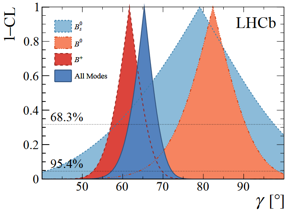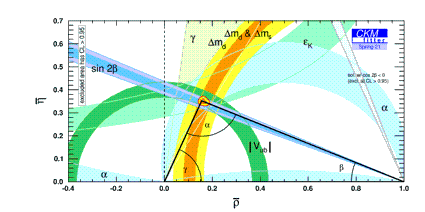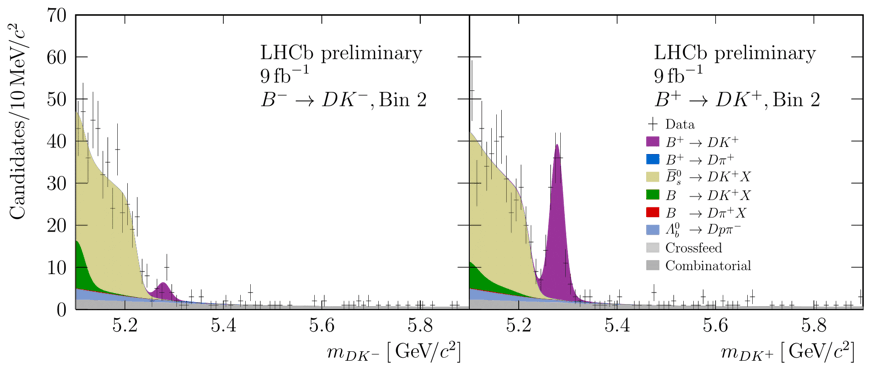The largest CP violation ever observed.

This week, at the 10th Annual Large Hadron Collider Physics Conference, LHCP2022, LHCb presented results of the determination of the Cabibbo–Kobayashi–Maskawa (CKM) angle γ from the study of the CP-violating observables in beauty particle decays B±→DK± and B±→Dπ±. The particular charmed D meson decays into four charged mesons K∓π±π±π∓ were used in this analysis.
LHCb is an experiment set up to explore what happened after the Big Bang that allowed matter to survive and build the Universe we inhabit today. Therefore LHCb physicists are measuring differences between properties of matter and antimatter, called CP violation by experts. CP violation was discovered experimentally in K meson decays in 1964. M. Kobayashi and T. Maskawa proposed in 1973 a mechanism which could incorporate CP violation within the Standard Model requiring at least 3 families of particles; they were awarded the Nobel prize in Physics in 2008 for this idea. The size of this violation is set by the parameter η, which is shown as the y axis in the left figure below. Constraints on η and the related parameter ρ (the x-axis) are measured in various ways in different experiments as shown in the compilation made by the CKMfitter group in the left image below. The constraints show that in fact the values of ρ and η within the small colored region in the center of the images are compatible with the experimental results and confirm in this way the Kobayashi and Maskawa Standard Model mechanism of CP violation. However, since this mechanism does not explain the large quantity of matter observed in the Universe physicists are searching for other sources of CP violation outside the Standard Model.
An interesting possibility is to measure precisely the angle γ of the triangle shown in the left image below in processes in which the new physics contribution is possible and in processes in which it is not. Differences between measurements in these two cases would be a sign of new physics. The measurement of the angle γ in different processes is one of most important goals of the LHCb experiment.

Analysis of B±→DK± decays provides a powerful method to measure the angle γ. The LHCb collaboration has performed such measurements in a wide ensemble of B and D decay modes to arrive to an overall result γ=(65.4+3.8-4.2)°, see combination plot above to the right. This result is already more precise than the original goal for the LHCb experiment. The charm D meson decays into K±π∓ and K±π∓π0 mesons made important contributions to the LHCb average. The D→K∓π±π±π∓ decay, reported today, belongs to the same category and is experimentally attractive due to its high branching fraction and absence of neutral pions in the decay.
The sensitivity to the angle γ has been significantly improved by studying the B±→DK± and B±→Dπ± decay rates in separate regions (bins) of the D→K∓π±π±π∓ phase space. The image above shows a typical invariant mass distribution in one of the bins separately for B– and B+ decays. The large difference between the heights of the mass peaks for B-hadrons with different charges indicate CP violation of 85%. This is the largest CP violation ever observed, higher than the previous record announced by LHCb two months ago.
The results are interpreted in terms of the angle γ and other related parameters. The value of γ found in this way is shown at the top of this news, where the first uncertainty is statistical, the second systematic and the third from the external inputs related to the D-meson decay (for experts: the coherence factors and strong phases). This result is anticipated to reduce significantly the uncertainty on this key parameter of the Standard Model when combined with measurements using other B and D decays.
Read more in the LHCb conference presentations [1] and [2] and also in the forthcoming paper.


